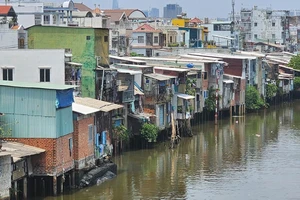
For many years, the municipal authorities have called upon public resources to join hand in building new underpasses, overpasses, or roads at frequently congested spots such as those on Hanoi Highway. For instance, after the construction of a new underpass near Suoi Tien Theme Park in District 9 and the expansion of National Way No.1 passing this area, the traffic status has been positively improved.
Statistics from the HCMC Department of Transport reveal that in the last 10 years, the city has renovated and built 384km/272km of road (accounting for 141 percent), 72/76 bridges (94.7 percent). The ratio between land use for transport and for other facilities now reaches 10.01 percent over 12.2 percent. This ratio is to increase to 12.2 percent at the end of 2020.
The density of street at the moment is 2.19km per km2, and to come to 2.2km per km2 at the end of this year.
Many new key facilities are now in use such as Pham Van Dong Street, the connecting road between Nguyen Van Huong Street and Hanoi Highway, Phu Huu Bridge on the Eastern Ring Road, the new overpass at Go May Intersection, the overpass on Truong Son Street, the connecting road between Tan Son Nhat – Binh Loi – the Outer Ring Road, or the overpass at Go Vap six-way intersection.
At the moment, HCMC is focusing on upgrading the traffic infrastructure around Saigon Hi-tech Park, Vietnam National University – HCMC and especially Hanoi Highway (the main route to link HCMC to Central and Northern provinces) for the development of the eastern section of the city.
Obviously, the eastern part will be the one with the most modern transport facilities. It is going to welcome Metro Line No.1 (Ben Thanh – Suoi Tien from the downtown to District 9) at the end of this year. Besides that are current bustling routes like Long Thanh – Dau Giay Express Way, Ring Road No.2, Mai Chi Tho Avenue.
Most impressively, the three-leveled intersection of An Suong has been introduced to connect HCMC with Tay Ninh Province, Binh Phuoc Province, and Cambodia, making way for more economic breakthroughs in the future.
In the near future, the HCMC Department of Transport will concentrate on expanding 5 essential routes in the eastern section, namely Le Van Viet, La Xuan Oai, Lo Lu, Do Xuan Hop, and Nguyen Duy Trinh. They are estimated to finish in 2025.
Meanwhile, HCMC People’s Committee has agreed with the plan to expand Nguyen Thi Dinh Street and to construct a new road linking Cat Lai Port to Phu Huu Port. Another plan to build An Phuc Intersection and Cat Lai Bridge (linking District 2 to Dong Nai Province) will be submitted to the Ministry of Transport for approval.
In order to tackle traffic congestion in the western section of HCMC, new overpasses and streets will be built, many parts of National Ways No.1 and No.22 will be expanded, with the total investment amount of VND1,600 billion (approx. US$69 million).
Therefore, currently the municipal authorities are trying their best to balance several resources so that urgent traffic projects can be financed first by state budget, and reimbursement will be collected later. Simultaneously, a proposal to allow HCMC to freely choose investors for highly feasible projects has been submitted to the Prime Minister.
























